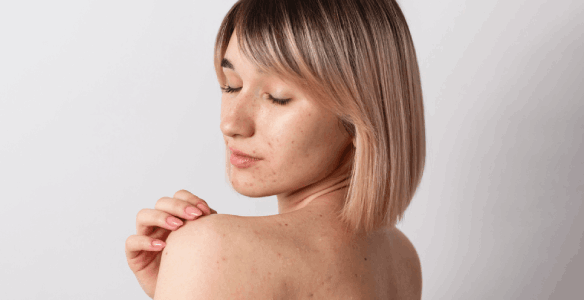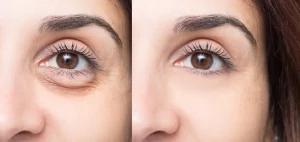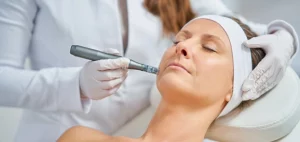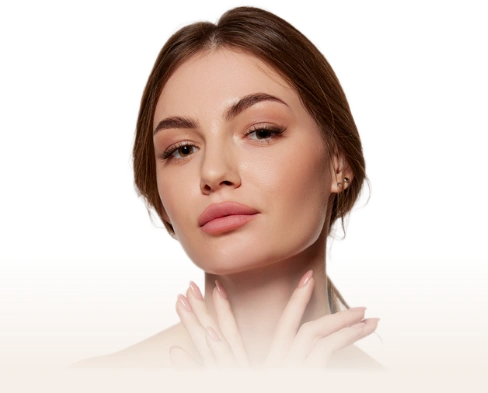Technically, fungal acne is not acne so here we will learn about closed comedones vs. fungal acne. That is a result of a very distinct cause.
Bacteria are to blame for clinical acne. A bacterial overgrowth that soon develops into acne and pimples can be brought on by clogged pores brought on by pollution, dead skin cells, sebum, and heavy skin care products.
Conversely, yeast overgrowth causes fungus to cause acne (Malassezia). Your skin naturally contains yeast. You may develop acne, though, if the hair follicles become overgrown.
What is fungus-induced acne resemble? Little red pimples can appear on your chest, upper back, forehead, cheeks, or fungus acne.
Brief Overview of Fungal Acne
Fungal acne, also known as Malassezia folliculitis or Pityrosporum folliculitis, is a skin condition caused by the overgrowth of yeast (Malassezia) in the hair follicles. It often presents as small, itchy, uniform pustules or papules and can be mistaken for traditional acne. This condition thrives in warm, humid environments and is common in areas with excessive sweating and oil production.
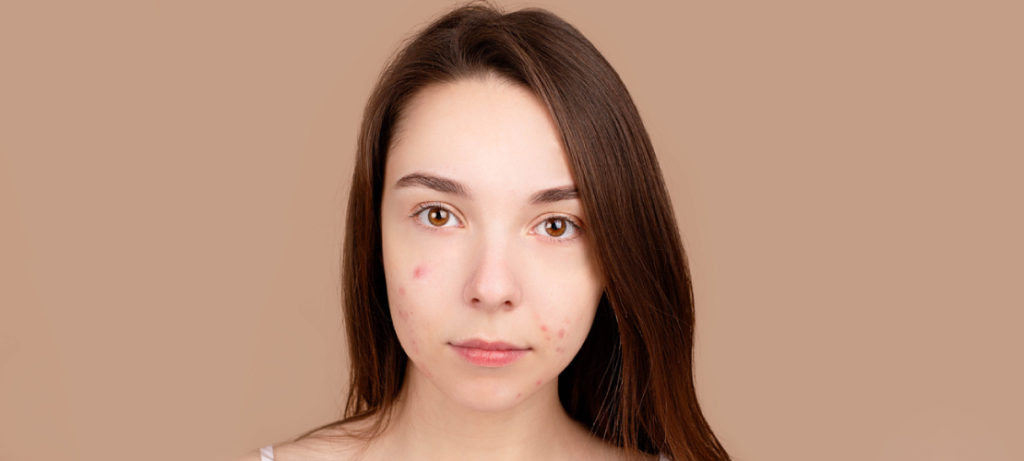
Different Types of Fungal Acne
Pityrosporum Folliculitis
Characterized by itchy, acne-like eruptions, often in areas with high oil production.
Malassezia Folliculitis
Similar to Pityrosporum folliculitis, caused by Malassezia yeast, leading to itchy, uniform pustules.
Brief Overview of Closed Comedones
Closed comedones, commonly known as whiteheads, are a type of non-inflammatory acne that presents as small, flesh-colored bumps. These bumps occur when dead skin cells, oil, and bacteria become trapped within the hair follicles. Unlike blackheads, which have an open surface, closed comedones have a closed surface, which prevents the contents from being exposed to air.
What are Closed Comedones and Comedonal Acne?
A specific type of acne is one with comedones. Comedonal acne is less severe because it doesn’t result in cysts and nodules like inflammatory acne does.
Open comedones (blackheads) and closed comedones are the two types of comedonal acne (whiteheads).
Contrary to popular belief, dirt doesn’t turn blackheads black. The blackness you observe results from the dirt obstructing your pores and oxidizing since the acne is open.
Also, whiteheads aren’t necessarily white. Closed comedones and fungus acne can both frequently appear as red pimples, making them quite similar.
Different Types of Closed Comedones
Microcomedones
Early-stage comedones are tiny and not visible to the naked eye.
Macrocomedones
Larger, visible closed comedones that appear as small, flesh-colored bumps on the skin.
Causes: Closed Comedones vs Fungal Acne
Aspect | What Causes Closed Comedones? | What Causes Fungal Acne? |
Cause | Overgrowth of Malassezia yeast in hair follicles.
| Blockage of hair follicles by dead skin cells and sebum. Closed comedones (whiteheads) are non-inflamed skin lesions that develop when oil and skin debris clog skin pores. To help remove the clog and enhance your appearance, they can be treated with over-the-counter or prescription lotions and physical extraction. |
Triggers | Warm, humid environments, excessive sweating | Hormonal changes, genetic predisposition |
Contributing Factors | Oily skin, use of oily skincare or hair products | Use of comedogenic products, poor skincare |
External Factors | Tight clothing, lack of proper hygiene after | Certain medications, stress |
Internal Factors | Weakened immune system, antibiotics disrupting skin flora | Hormonal imbalances (e.g., during puberty or menstruation) |
Where Does Fungal Acne Appear?
- Forehead: Frequently affected due to high oil production and sweat accumulation.
- Cheeks: Can appear in areas with oily skin and where hair follicles are abundant.
- Face: Often seen in the T-zone where the skin tends to be oilier.
- Chest: Common in areas that trap sweat and oil under clothing.
- Back: Affected due to sweat, oil, and friction from clothing.
- Neck: This can occur in the folds of the skin where sweat accumulates.
- Chin: Appears in areas with high oil production and occlusion from masks or clothing.
- Jawline: This can be triggered by occlusive clothing or hair touching the skin.
Where Do Closed Comedones Appear?
- Forehead: Frequently seen due to oil production and hair products touching the skin.
- Cheeks: Appear where skin care products or makeup may clog pores.
- Face: Common in areas with higher oil gland activity, especially in the T-zone.
- Chest: Develops from blocked pores due to sweat, oil, and tight clothing.
- Back: Common due to sweat, oil, and friction from clothing or backpacks.
- Neck: This can appear due to skincare or hair products that clog pores.
- Chin: Common in areas with high oil production and hormonal influences.
Closed Comedones vs Fungal Acne: what are the differences?
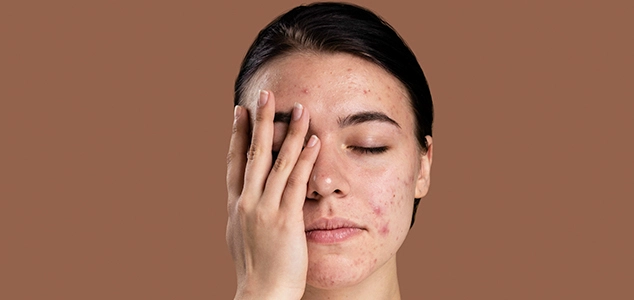
Closed comedones vs. fungus acne have extremely similar appearances. They appear as tiny red pimples on your forehead, upper back, or cheeks. But they are in no way comparable. One is that many factors bring them on.
Yeast overgrowth is the cause of fungal acne. In contrast, closed comedones develop due to an overproduction of sebum in a layer of skin.
Closed comedones vs. fungal acne require completely different approaches to therapy.
Closed Comedones vs Fungal Acne: Symptoms
| Aspect | Fungal Acne | Closed Comedones |
| Appearance | Small, itchy, uniform pustules or papules | Small, flesh-colored bumps |
| Texture | Often feels rough due to pustules | Non-inflamed, smooth, or slightly bumpy |
| Itchiness | Often itchy | Often itchy Typically not itchy |
| Inflammation | Can be inflamed | Non-inflammatory |
Closed Comedones vs Fungal Acne: Medication
Aspect | Fungal Acne | Closed Comedones |
Tropical Medication | Ketoconazole cream, clotrimazole cream | Retinoid creams, salicylic acid |
Oral Medication | Fluconazole, itraconazole | Oral retinoids, hormonal treatments |
Fungal Acne vs. Bacterial Acne
| Aspect | Fungal Acne | Bacterial Acne |
| Cause | Overgrowth of Malassezia yeast | Propionibacterium acnes bacteria |
| Symptoms | Itchy, uniform pustules | Red, inflamed pustules and papules |
| Treatment | Antifungal treatments | Antibiotics, benzoyl peroxide |
| Appearance | Often uniform in size, clusters | Varying sizes, scattered |
Folliculitis vs. Acne
| Aspect | Folliculitis | Acne |
| Cause | Inflammation of hair follicles | Blockage and inflammation of sebaceous glands |
| Appearance | Red, inflamed bumps, sometimes with pus | Varies from comedones to cysts |
| Common Areas | Any hair-bearing area | Face, back, chest |
| Treatment | Topical or oral antibiotics, antifungals | Topical treatments, oral medications |
How to Treat Fungal Acne and Closed Comedones
Your therapy method can only be successful if you mistake fungal acne for closed comedones. Because of this, it’s crucial to determine the type of acne you have before beginning any treatment.
Topical retinoids and drying agents are effective treatments for comedonal acne. Also, reducing the excessive oil production in your skin can successfully treat comedones.
You might require a prescription for systemic antibiotics if you have closed comedones and inflammatory acne. As an alternative, hormonal medications (such as contraceptives) can potentially aid in treating severe acne.
But antibiotics won’t help you much if you have fungal acne. You will require anti-fungal medicine instead. Try a topical antifungal cream first, but you could need more if your condition is serious.
Also, under the guidance of a board-certified dermatologist, you might need to attempt oral antifungal medication if your skin doesn’t respond to topical therapy.
Remember not to pop pimples no matter what form of acne you have. Open lesions are more problematic than acne since they are so easily contaminated.
When an open zit heals, it may leave a scar or melanin spots, which cause the surrounding skin tone to shift. Because of this, it is preferable to put your faith in a treatment alternative.
Fungal Acne Treatment
Spending time in damp or humid environments increases the risk of developing fungal acne. The breeding habitat for bacterial acne is warm, damp skin. You should take certain precautions to reduce your chance of developing fungal acne if you exercise frequently, participate in sports, or reside in an area with excessive heat and humidity all year.
Try to shorten the period you perspire heavily. Shorter sessions or other kinds of exercise may result from this. Keep your skin from chafing during exercises by using comfortable, loose-fitting clothing made of breathable material, such as cotton.
After working out, take a shower and put on dry clothing as soon as you can. Taking a chilly or cold shower after exercising can help you stop sweating. You should visit your doctor for prescription antifungal medications or topical antifungal treatments for fungal acne because fungus-related acne is essentially a yeast infection. Make sure to apply any creams or ointments in the direction that your hair naturally grows.
Avoid rubbing the lumps while waiting for your fungus acne to disappear. This makes it more difficult to cure the infection and can spread it.
Closed comedones treatment
Treatment for comedones acne can be quite difficult. This kind of breakout is frustrating since treatment methods can take many weeks to a few months to start working.
Changing to a healthier lifestyle is the first step. Limit your intake of sweets, dairy products, and harmful fats. If you smoke, give it up. Make careful to cleanse your face at most twice each day.
Next, try a topical medication available without a prescription that has one of these active ingredients:
- Salicylic acid
- Glycolic acid
- Azelaic acid
- Benzoyl peroxide
- Retinoids
- Also, opt for oil-free, non-comedogenic moisturizers, and cosmetics.
If over-the-counter remedies are ineffective, a prescription-strength drug can help. They could consist of hormone therapy, prescription-strength retinoids, or antibiotics. Dermatologists can also do electrosurgery, cryotherapy, or microdermabrasion, which involves freezing the skin’s surface to eliminate comedones.
Red and blue light treatment is a relatively modern but professionally tested way of treating acne. Red light reduces inflammation and promotes healing, while blue light eliminates acne-causing germs on the skin.
Closed Comedones vs Fungal Acne: Treatment
Aspect | Fungal Acne | Closed Comedones |
Tropical Treatment | Antifungal creams (e.g., ketoconazole, clotrimazole) | Retinoids (e.g., tretinoin), salicylic acid |
Oral medication | Oral antifungals (e.g., fluconazole) | Oral retinoids, hormonal treatments |
Skincare Routine | Gentle, non-comedogenic, and antifungal skincare products | Exfoliating cleansers, non-comedogenic moisturizers |
Professional Treatment | Microneedling, laser treatment | Microneedling, chemical peels, extraction |
Conclusion
Acne caused by fungi and comedones is not the same thing. In the clinical sense, fungal acne is not acne, as we have already discussed.
Malassezia, also known as Pityrosporum folliculitis, is a fungus that affects the hair follicles, where comedonal acne is brought on by a concoction of bacteria, oil, and clogged pores.
Because of this, the methods of treating through typical acne medication or other method, these two skin disorders are highly dissimilar. Determining which illness you have might be challenging, but speaking with a doctor or dermatologist can help you receive the right diagnosis and the best possible care.
Frequently Asked Questions
Q1. How do I know if I have Comedonal or fungal acne?
These tiny papules or pustules resemble a mini-acne outbreak. While comedonal acne can include lesions of all shapes and sizes, fungal acne typically has a more uniform appearance. Redness, irritation, and occasionally a stinging feeling are typical signs of fungal acne.
Q2. How do you know if comedones are closed?
A closed comedo is like a menacing whisper compared to an inflamed, angry-red pimple, the skin-care equivalent of a scream. Closed comedones are white or skin-colored bumps that progressively enlarge beneath the skin’s surface until they are large enough to be seen in profile. They appear to have no head and are impossible to pop.
Q3. What types of acne are closed comedones?
Whiteheads: Often called closed comedones, develop when an entire hair follicle is obstructed. Blackheads, also known as open comedones, are dark spots on the skin that develop due to surface pigments accumulating in the pores. Some individuals think that the dots are dirt.
Q4. Are closed comedones permanent?
Closed comedones can occasionally disappear on their own without requiring much care. However, they typically don’t.
Q5. Can fungal acne affect hair follicles on the scalp?
Yes, fungal acne can affect hair follicles on the scalp, leading to symptoms such as itching, redness, and small pimples or pustules around the hair follicles. Prompt treatment with antifungal agents is typically necessary for resolution.
Q6. How to know if your acne is fungal?
To distinguish fungal acne, look for uniform, itchy bumps that cluster and worsen with humidity. Consult a dermatologist for a definitive diagnosis.
Q7. How long do fungal acne and closed comedones last?
Fungal acne can improve in weeks with antifungal treatments. Closed comedones may persist longer, often requiring consistent skincare and possibly dermatological intervention.
Q8. Is salicylic acid good for fungal acne?
Salicylic acid isn’t typically effective for fungal acne as it targets bacteria and exfoliates the skin. Antifungal treatments like ketoconazole are more appropriate. fungal acne lesions Managing fungal acne is essential.
Q9. How do I know if my acne is bacterial or fungal?
A dermatologist can determine acne type through visual inspection or skin concerns, identifying bacterial acne by inflamed pustules and fungal acne by uniform, itchy bumps.
Q10. How do I know if my acne is hormonal bacterial or fungal?
Hormonal acne is often around the jawline and varies with menstrual cycles. Bacterial acne presents as inflamed pustules, while fungal acne lesions show uniform, itchy bumps typically worsened by humidity.
Q11. Can you treat closed comedones at home?
Yes, closed comedones can be treated at home with topical treatments containing ingredients like salicylic acid or retinoids, which help exfoliate and unclog skin pores. Consistent skin care routines and gentle exfoliation can also help prevent their recurrence.
Q12. Are closed comedones fungal acne?
No, closed comedones are not fungal acne. Closed comedones are a type of acne caused by clogged pores while developing fungal acne is a yeast overgrowth on the skin that presents differently.
Q13. How do dead skin cells contribute to the blockage of pores?
Dead skin cells can accumulate and mix with sebum, forming a plug that obstructs pores. This blockage traps bacteria and leads to acne formation.

About The Author
Dr. Syra Hanif M.D.
Board Certified Primary Care Physician
Dr. Hanif is the Director of Aesthetic Medicine. She is a board-certified physician in Aesthetic Medicine who specializes in using non-surgical alternatives in order to enhance one's appearance through Botox and fillers.
Read More




